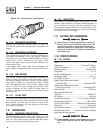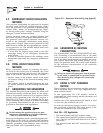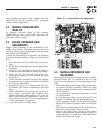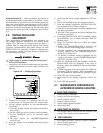
11
• The control board WILL monitor all engine condi-
tions and shut down on all the faults listed in this
document.
Pos2 OFF — ATS Application
• The control board will perform all of the automatic
features listed in this document.
• The two-wire start connections, wires 178-183,
should NOT be connected.
NOTE:
If the generator is installed in conjunction with an
engineered GTS type engineered transfer switch,
refer to the applicable transfer switch manual for
exact operating parameters and timing sequenc-
es.
2.10 BATTERY INSTALLATION
DANGER
Standby generators installed with automatic
transfer switches will crank and start automati-
cally when NORMAL (UTILITY) source voltage is
removed or is below an acceptable preset level.
To prevent such automatic start-up and pos-
sible injury to personnel, do not connect battery
cables until certain that normal source voltage
at the transfer switch is correct; the generator
main line circuit breaker is switched to OFF; the
AUTO/OFF/MANUAL switch on the control con-
sole is switched to OFF; the 15A and 5A fuses
have been removed from the control console;
utility fed supply to battery charger (terminals
N1 and N2) is removed; and the system is ready
to be placed into operation. Ensure that the 5A
and 15A fuses in the control panel are removed
when connecting or disconnecting battery
cables.
Storage batteries give off explosive hydrogen
gas. This gas can form an explosive mixture
around the battery for several hours after charg-
ing. The slightest spark can ignite the gas and
cause an explosion. Such an explosion can shat-
ter the battery and cause blindness or other
injury. Any area that houses a storage battery
must be properly ventilated. Do not allow smok-
ing, open flame, sparks or any spark producing
tools or equipment near the battery.
Battery electrolyte fluid is an extremely corro-
sive sulfuric acid solution that can cause severe
burns. Do not permit fluid to contact eyes, skin,
clothing, painted surfaces, etc. Wear protective
goggles, protective clothing and gloves when
handling a battery. If fluid is spilled, flush the
affected area immediately with clear water.
Do not dispose of the battery in a fire. The bat-
tery is capable of exploding.
Do not open or mutilate the battery. Released
electrolyte can be toxic and harmful to the skin
and eyes.
The battery represents a risk of high short circuit
current. When working on the battery, always
remove watches, rings or other metal objects,
and only use tools that have insulated handles.
2.10.1 VENTED BATTERIES
The electrolyte is a dilute sulfuric acid that is
harmful to the skin and eyes. It is electrically
conductive and corrosive. The following proce-
dures are to be observed:
• Wear full eye protection and protective clothing,
• Where electrolyte contacts the skin, wash it off
immediately with water,
• Where electrolyte contacts the eyes, flush thor-
oughly and immediately with water and seek
medical attention, and
• Spilled electrolyte is to be washed down with an
acid-neutralizing agent. A common practice is to
use a solution of one pound (500 grams) bicarbon-
ate of soda to one gallon (4 liters) of water. The
bicarbonate of soda solution is to be added until
the evidence of reaction (foaming) has ceased. The
resulting liquid is to be flushed with water and the
area dried.
Lead acid batteries present a risk of fire because
they generate hydrogen gas. The following pro-
cedure are to be followed:
• DO NOT SMOKE when near batteries,
• DO NOT cause flame or spark in battery area, and
• Discharge static electricity from body before touch-
ing batteries by first touching a grounded metal
surface.
Servicing of batteries is to be performed or super-
vised by personnel knowledgeable of batteries and
the required precautions. Keep unauthorized person-
nel away from batteries.
The recommended battery is Group 26, 12VDC, 550
CCA/75 AH minimum. All batteries must be at 100
percent state-of-charge before they are installed on
the generator.
Section 2 — Installation
Liquid-cooled 25 kW Generators


















